Live vs. Artificial Plants in the Freshwater Aquarium
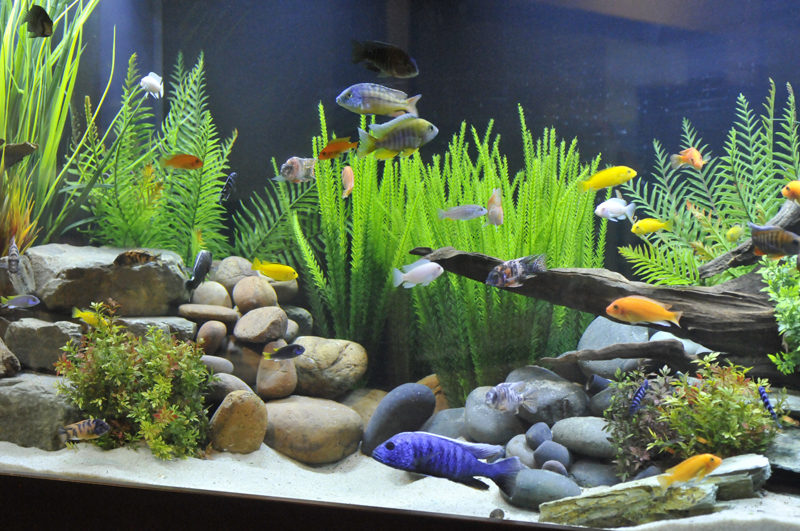 There’s no doubt a well-maintained aquarium, delightfully aquascaped with live plants, is a beautiful sight. However the choice sometimes comes down to whether to keep the fish or the plants when these tankmates are not compatible. Many fish will either nibble your plants into raggedy eyesores or downright eat them up! Others are natural diggers, uprooting dislodging and rearranging your flora all the time. The outcome of this constant planting and replanting can be stressed plants and aquarium owners!
There’s no doubt a well-maintained aquarium, delightfully aquascaped with live plants, is a beautiful sight. However the choice sometimes comes down to whether to keep the fish or the plants when these tankmates are not compatible. Many fish will either nibble your plants into raggedy eyesores or downright eat them up! Others are natural diggers, uprooting dislodging and rearranging your flora all the time. The outcome of this constant planting and replanting can be stressed plants and aquarium owners!
What’s the solution? Change your fish? Do without plants at all? How about artificial aquascaping?
Purists cringe at the thought of using artificial plants in aquariums even though there are many realistic looking choices available today But think about it? What’s the main reason for growing plants besides the aesthetics of it? That’s right, shelter for your fish and places for egg-laying. Plastic plants do these jobs just as well as live ones. The fish don’t care, except for those who have become excessive nibblers and they’ll soon get over it. Algae grows just as well on artificial surfaces, so your algae-eaters will be content. Hiding places among the artificial flora can still be comforting and also serve as a nesting area for your egglayers.
If your community is comfortable with live plants and you enjoy growing them, by all means continue to do so! But if you want both and are willing to go “plastic”, the rewards can be just as satisfying to you and your fish!
Why Fish Fight
 It’s always bad news when fish injure or kill each other in our tanks, or in our customers’ tanks. Understanding what’s going on may help prevent these incidents. The five motives for piscicide are predation, reproduction, territory, dominance and pathology.
It’s always bad news when fish injure or kill each other in our tanks, or in our customers’ tanks. Understanding what’s going on may help prevent these incidents. The five motives for piscicide are predation, reproduction, territory, dominance and pathology.
Predation is feeding behavior, and usually involves a large fish swallowing or biting a much smaller fish. Almost any fish can be a predator if presented with the right size victim. A few fish also feed on parts of other fish, such as eyes, scales or fins. Thankfully, most of these species have never become common in the aquarium trade.
Reproductive violence includes spouse abuse, fry-eating and fry-defending. Mating behavior in fish often includes contests of strength, with jaw-locking and wrestling. In the wild, a fish that’s tiring in such a contest can break off and swim away for a while; in an aquarium there is no “away.” A fish that is weaker may be rejected and driven away by the winner, who will then await a stronger suitor. Again, in a fish tank the rejected fish can’t leave, and the winner will keep trying to drive it out until it is killed. Fry-eating is, oddly enough, an evolutionary survival trait. Laying eggs is a huge expenditure of calories, and a fish in an unsafe or unhealthy environment may retrieve those calories to help it survive to try again when conditions are better. Conversely, a fish defending eggs or fry may become quite fierce, killing or injuring even much larger fish if they don’t back away. In species that don’t normally care for their young, fry-eating is just hunger.
Some fish require a certain space that is “theirs”. Most territorial fish focus their aggression on similar species; a blue gourami might attack a dwarf or kissing gourami but ignore a platy or tetra in its territory. The size of a territory varies by species and terrain. A tank with lots of wood, rock or plants offers more visual barriers and therefore more territories than a mostly bare tank. Crowding can suppress territorialism; at a certain point most fish (except bettas!) decide that defending a territory is hopeless and quit trying. That’s why you see a lot more fighting in a tank with 3 cichlids than in one with 20.
In some species there is a dominant fish in the school, who must assert his/her status by nipping and harassing the rest. In a large school this is harmless. Where there are only 2 or 3, the weakest fish is picked on relentlessly because there aren’t enough others to distract the alpha fish. If these species are kept singly, they often try to herd and control other species with damaging results. Many barbs, danios and some tetras fit this description; to prevent problems keep them in schools of 5 or more.
Understanding the roots of fish aggression can help us figure out steps to reduce it, but we can never be entirely sure. Despite their tiny brains, fish are individuals. Instincts evolved for lakes and rivers may not work as expected in a rectangular glass box. Living creatures are unpredictable; that’s why aquariums are more interesting than fish screen-savers. Whether influenced by a brain tumor, low blood sugar or too many video games, sometimes a fish is just plain mean.
Build Your Aquarium Around Your Fish
There are many challenges in fishkeeping. One of them is to successfully maintain fishes that grow reasonably large or are so active or territorial that they need a spacious aquarium tank in which to thrive. Like any other animal, fish need adequate accommodation, regular feeding, clean conditions, and appropriate exercise. In fact, you should always give as much consideration to owning a fish as you would to owning any other pet.
So…you find yourself standing in front of a display tank, contemplating bringing home that really special looking fish, little realizing (unless you buy your fish from Fintastic because we’d tell you) that that tiny little fish will outgrow your aquarium in a very short time.
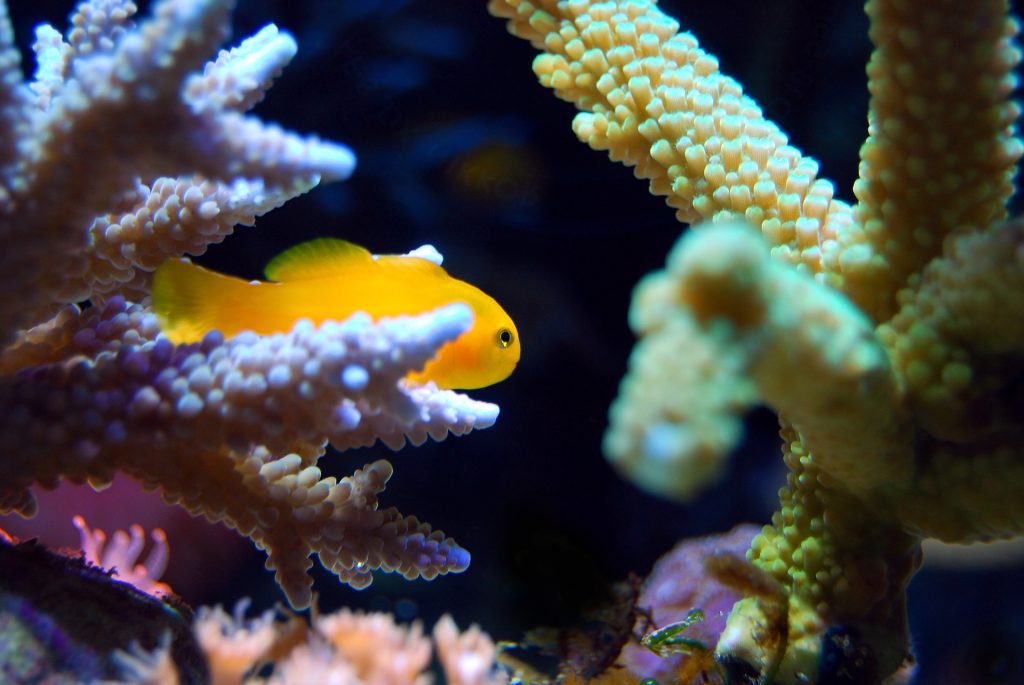
It is always difficult to know where to start when planning a new aquarium. The temptation is to buy your pet first and then consider the problems of housing it. Misjudging the long-term implications is easy, especially if the fish you have chosen is a juvenile. After all, it shouldn’t grow that fast, you hope! Most fish sold are juveniles, some will get just a little larger, but others may get huge. Oscars are a good example, growing as large as 15 inches. A large aquarium, measuring at least 48″x18″x18″ is essential. Other species, like many of the aggressive cichlids, are highly territorial and will need a lot of room to thrive.
The best way to go about things is to build your tank around the fish you want to keep. Having decided on a fish that interests you, the first task is to determine the minimum tank size it will need at maturity, not what it needs now when it’s as small as a guppy! Next investigate the ideal filtration system to maintain the required water conditions. A filter system can never be too large for the aquarium. However big the tank you provide is, it will never be anywhere near the size of the lake or river (or ocean!) in which the fish lives in the wild! And most importantly, before you buy any fish you’re not familiar with, become familiar with it. Compatibility with other species is only one issue, size and personality are important too.
Popular Pond Fish FAQs
Fish are wonderful critters that add color, movement, and plenty of enjoyment to the water garden. The subject of pond fish occurs frequently during conversations about water features. In fact, the same questions seem to rise to the surface on a regular basis, which is why we call them FAQs … or frequently asked questions. Here are just a few:
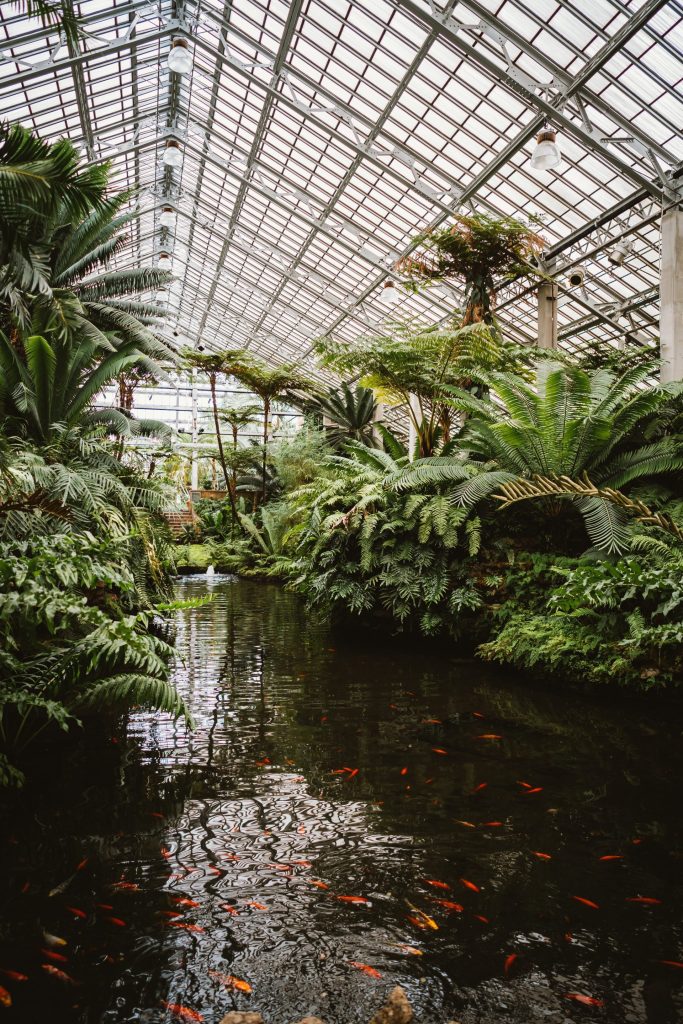
Q. Don’t fish increase the workload for a water gardener?
A. In simplest terms, the answer is no! In fact it’s just the opposite. Fish constitute 20% of the naturally balanced, holistic, organic ecosystem that makes up your water garden. Fish actually play a critical role in reducing your workload. Fish do the following…
- Help control insects by eating them and their larvae
- Keep the plant growth in balance by eating them
- Help fertilize the plants with their waste
- Make great pets that you will learn to name and to love
- Add lots of color and movement to your pond
Q. What happens if I forget to feed the fish? Won’t they die or become unhealthy?
A. Your fish will do just fine if you forget to feed them once in awhile since they consume the bacteria that coats the rocks and gravel at the bottom of the pond. However, feeding the fish provides a great opportunity for you and your family to interact with them. Actually the one mistake you can make is to overfeed them or feed them too often. When temperatures fall below 50 degrees Fahrenheit, you definitely should avoid feeding them at all.
What about the fish in the winter? Won’t they freeze to death in the pond? Will I need to bring them in the house?
A. No. If you simply make sure that your pond is at least two feet deep, the proximity of the earth to the pond’s surface will not allow the latter to freeze any deeper than 8”. That leaves 16” for the fish to lounge around and basically hibernate over the winter. You do need to keep a hole in the ice using a floating heater or aerator for ponds to allow for the exchange of gasses (CO2 for oxygen). But other than that your fish will do just fine in the pond, all year round. Supplemental oxygen can also be supplied by running your waterfalls, adding a bubbler, or using the pump to churn the water near the surface.
How do I know how many fish are “too many fish” in my pond? How about too few? And just right?
A. Good question. Too many fish means too little food, problems with your fish, and potential for an overgrowth of algae. Too few fish means that the pond’s nutrition will not be satisfactorily absorbed and recycled. The general rule of thumb that we always suggest is 1 inch of fish per square foot of pond surface area. In other words, a 10’ x 10’ pond, which is 100 square feet, could support 100 inches of fish. This 100 inches could consist of 10 ten-inch fish, 20 five-inch fish, or… well you get the picture.
Won’t raccoons or other predators eat my fish?
A. Actually, raccoons don’t swim, so if ideally ponds built at least 2 feet deep and 8 feet wide, with some places for your fish to run and hide– they should be safe from those little nocturnal critters. The only critter that is a valid concern is the heron. Again, providing a place for your fish to hide (in and under water lilies, and other plants, or man-made fish caves) will help prevent any disastrous occurrence of fish-napping by a heron.
Recommendations For Feeding Frozen Foods to Your Fish
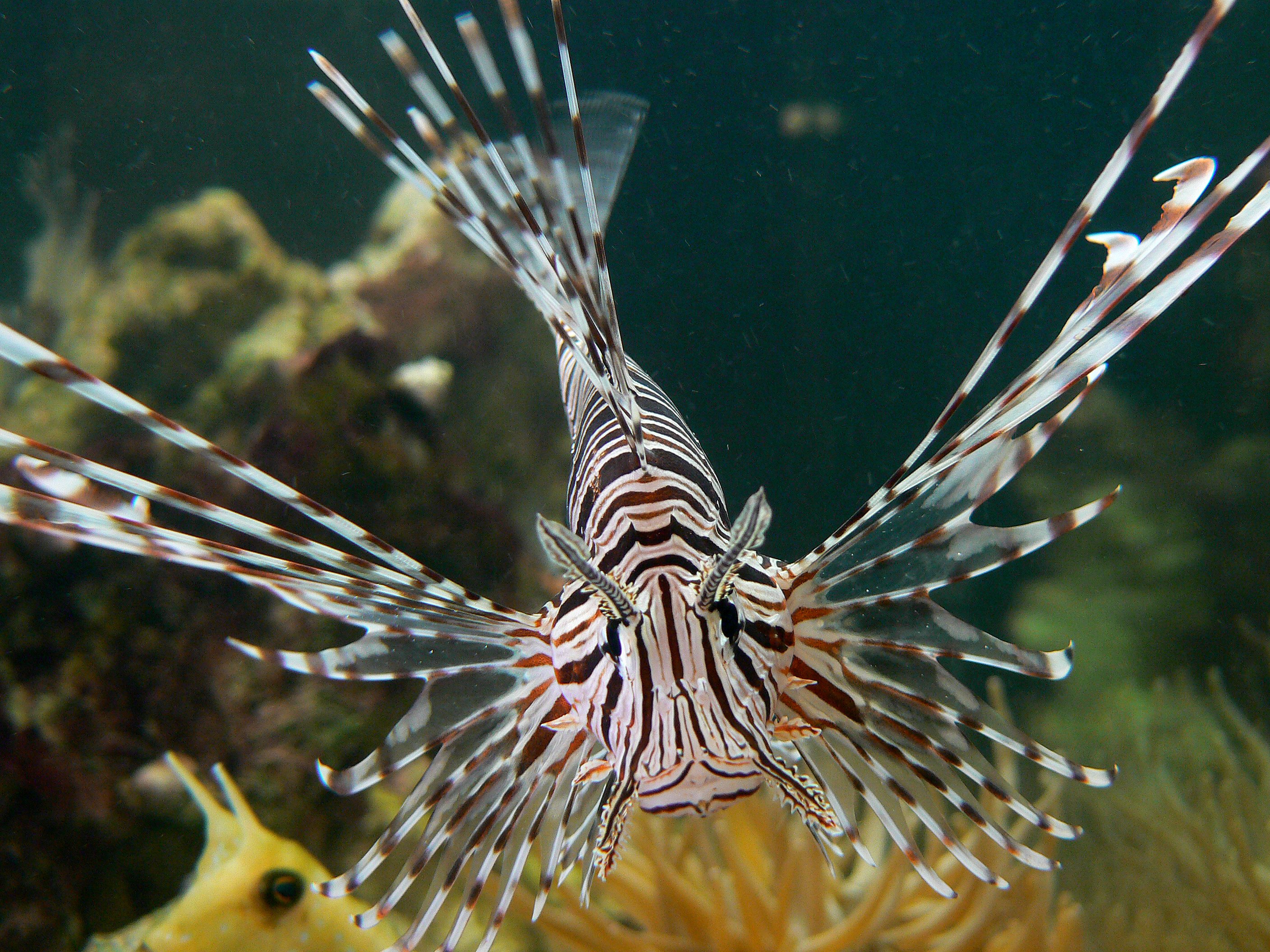 The intestinal lining of all fish is very sensitive and does not tolerate cold food very well. To serve frozen food properly, we suggest you thaw it first before feeding it to your fish. The following is our procedure for feeding frozen food here at Fintastic.
The intestinal lining of all fish is very sensitive and does not tolerate cold food very well. To serve frozen food properly, we suggest you thaw it first before feeding it to your fish. The following is our procedure for feeding frozen food here at Fintastic.• Decide how much food you’re going to use and place it in a plastic dish and leave it out to thaw for 30 minutes or so. Never leave it out any longer or it will spoil. Thawed food can be left in the refrigerator for a maximum of two days; any food left out longer than that should be thrown away.
• To supercharge your food with extra nutrition, dose your frozen food with a liquid multivitamin such as Sera Fishtamin or Kent Marine Zoe. Pour the liquid vitamin over the food and let it soak in as the food thaws. By doing this the food will soak up the vitamin like a sponge. In addition to getting all the food they need, the fish will be getting all the vitamins and minerals of a balanced diet.
• When completely thawed the food should have a soft, spongy feel. You can now feed your fish with it by squeezing it between your fingers just under the water’s surface. Let it drop away in pieces as the fish come up to eat it. For your own safety when feeding predatory fish such as eels, lionfish, triggerfish and groupers, and to eliminate fights over food, use feeding tongs to directly feed each fish.
• Never use hot water to thaw frozen food! This cooks the food and removes all the vitamins and minerals your fish so desperately need. It also breaks down the food into a nasty soup that your fish won’t eat and only serves to pollute your tank.
In conclusion, we recommend alternating between the various formulas of frozen food to ensure your fish a healthy balanced diet. A varied diet is the key to keeping your fish healthy and happy. After all, you want your fish not just to merely survive, but to thrive! Consult a Fintastic aquarium installation and maintenance specialist for more recommendations.
Gravel Vacuuming & Partial Water Changes
Regular, periodic, partial water changes are mandatory to maintain proper water quality and the only means by which nitrates can be maintained at acceptable levels. The gravel should be simultaneously vacuumed to remove trapped debris and uneaten food. Frequency will depend upon aquarium size, the species, size and number of fish, feeding habits and filtration quality.
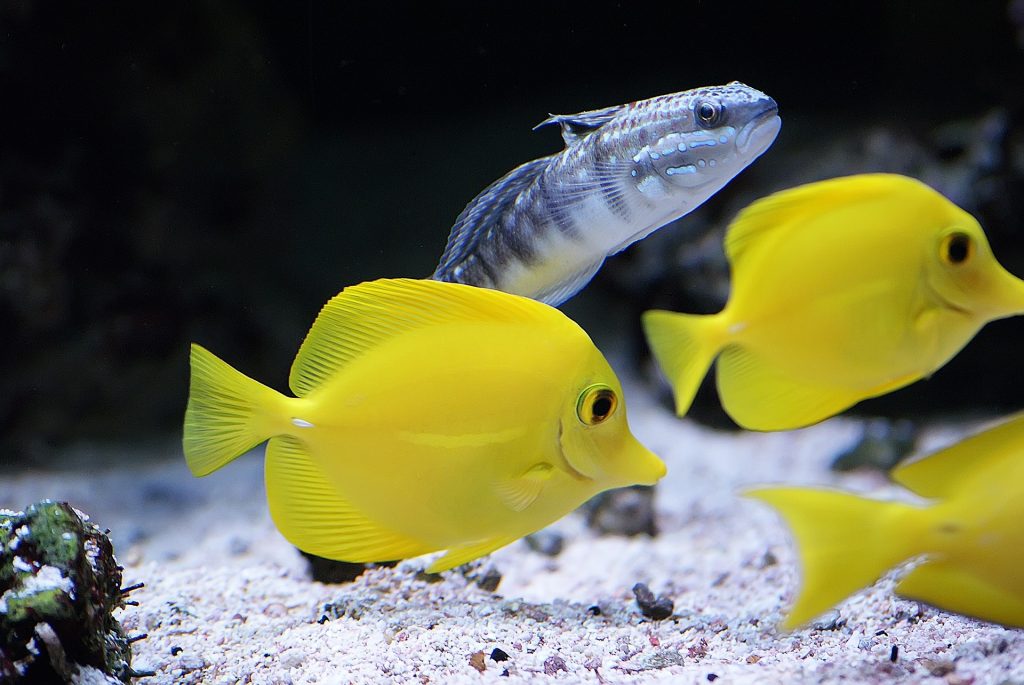
• A minimum of 25% of water volume should be changed every two weeks.
• Unplug aquarium heater(s) before beginning.
• Remove ornamentation other than live plants. “Walk the gravel cleaner across the entire bottom of the aquarium, agitating the gravel in the gravel cleaning tube until the water being removed flows clean.
• Refill the aquarium with tap water of the same temperature and pH as that of the aquarium water, after having added the prescribed amount of dechlorinator and aquarium salt (for marine tanks) to the water.
• Saltwater must be premixed and aerated or agitated for several hours to insure correct salinity and pH before being added to the aquarium.
• Wait 15 minutes before plugging the heater(s) back in.
Medication
Many medications require water changes before, during and/or after treatment. These must be done in accordance with the manufacturer’s instructions. Medicating without correcting improper water quality will have no beneficial effect. All carbon and other media must be removed from the filters prior to medicating. Do not turn off the filter! Just remove the chemical component of the filter.
Pond
When water temperature exceeds 50°-55°F, 25% of the pond volume should be changed every 3-4 weeks. This schedule should be complemented with larger volume water changes (50%+) associated with spring and fall maintenance. Particular attention should be paid to water quality and the related necessity of water changes during the hot summer months, with frequent monitoring of pH and dissolved oxygen required.
Saltwater Vs. Freshwater Aquariums
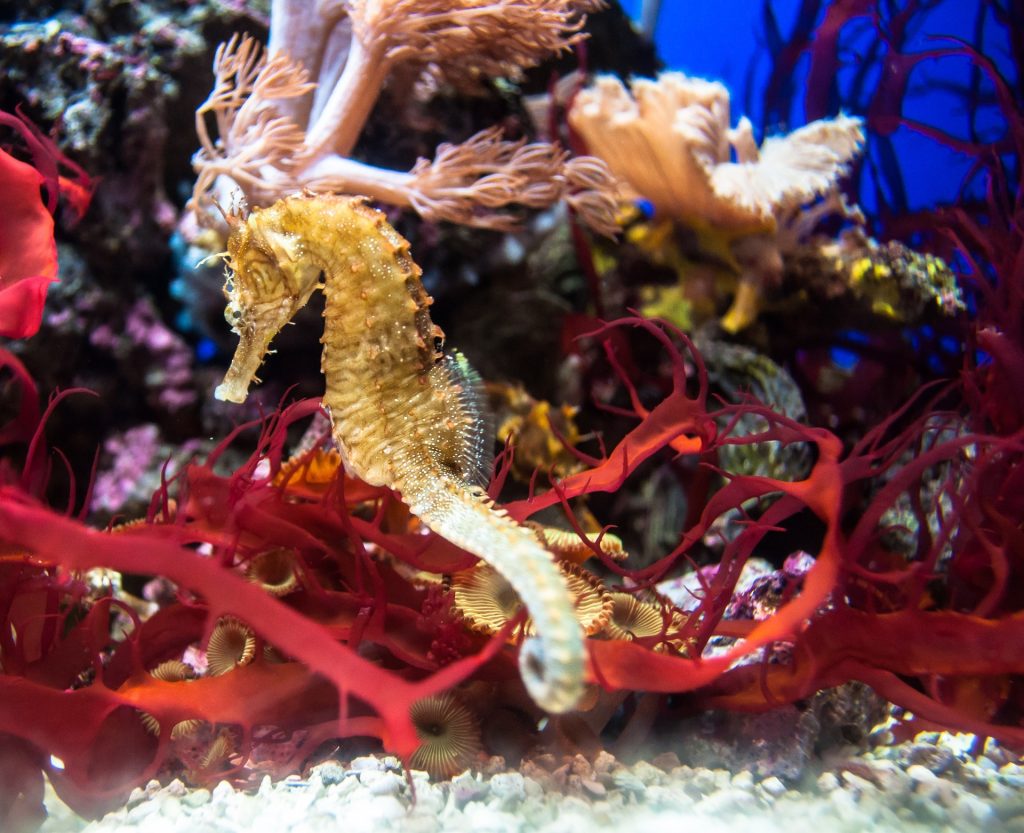
Thinking of putting in a new aquarium and can’t decide between going with a saltwater aquarium or a freshwater aquarium? There are a few things that you should consider to help you make your choice: commitment, cost and personal choice.
How Much Time do You Have to Commit?
Keeping any pet requires a certain amount of time and effort, and although fish are easier than many animals, keeping them happy and healthy is still a serious responsibility. Both salt and fresh water aquariums require daily feedings, frequent observation, and regular partial water changes and filter cleaning.
Marine tanks require a bit more attention at each of these steps. Feeding may be more complex, with different fish or corals requiring different foods, some of which may be frozen or live. Observation will include using test kits or devices to measure salinity, calcium, alkalinity, magnesium and other parameters. Water changes require pre-mixing salt water or purchasing and carrying pre-mixed salt water. Filter maintenance also includes emptying and adjusting your protein skimmer and may include maintaining reactors, refugia and other peripherals. Even changing light bulbs is more time consuming, as marine lighting fixtures are tightly sealed to protect the circuitry from salt and moisture.
Not all marine tanks will have all of these features, but leaving some of them out may limit the types of animals you can keep.
If you want a beautiful aquarium without all of this work, Fintastic offers an in-home maintenance program for marine and freshwater tanks.
What are the Costs Involved?
Most of the filtration and lighting choices for freshwater tanks are inadequate for marine use. Marine equipment is considerably more expensive, as are the fish and corals.
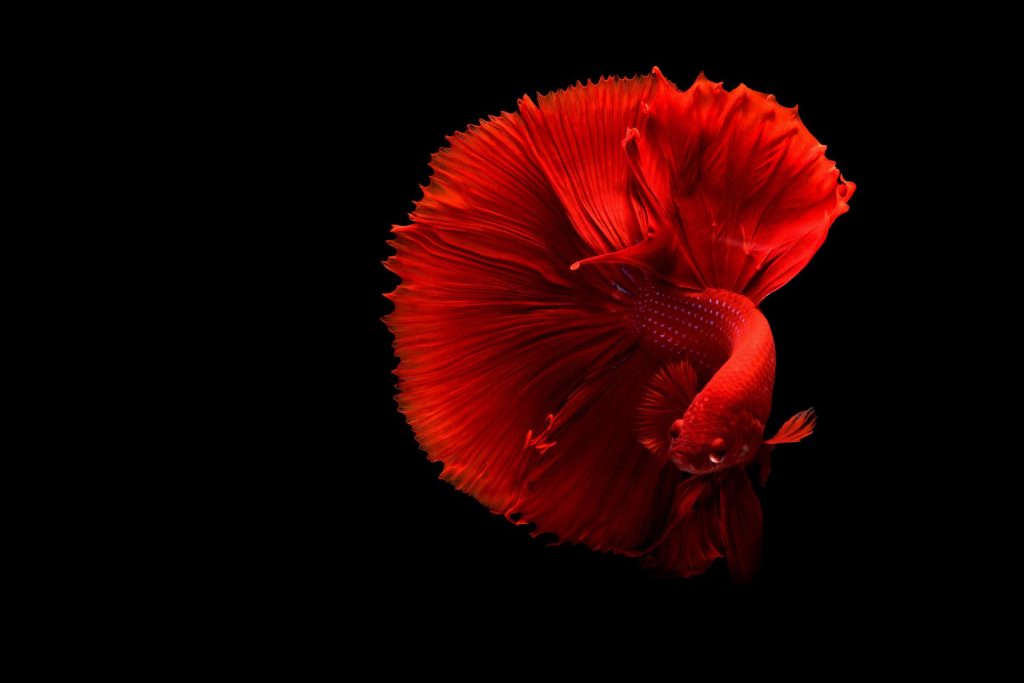
In both fresh and salt water, there is a trade-off of time vs. money. Better and more complete equipment will allow you to spend less time on maintenance; using barely adequate equipment will mean that you spend more time making up for the deficiencies in the hardware. Because of the many choices involved, a precise figure is impossible, but on average a marine aquarium will cost 3 to 5 times as much to set up as a freshwater tank of the same size.
What is Your Personal Choice?
Each side has something to offer that the other side cannot. In addition to affordability and ease, fresh water offers the possibility of breeding and raising fish, which is extremely rare in marine tanks. Marine tanks offer an unbelievable variety of creatures, from fish to corals, clams, crabs and feather dusters. The colors found in reef fish simply don’t exist in fresh water.
Ultimately, the final decision of whether a saltwater or a freshwater tank is best will depend on how much time and money you want to invest in your aquarium, and your personal taste in aquatic life.
Lighting the Water Garden
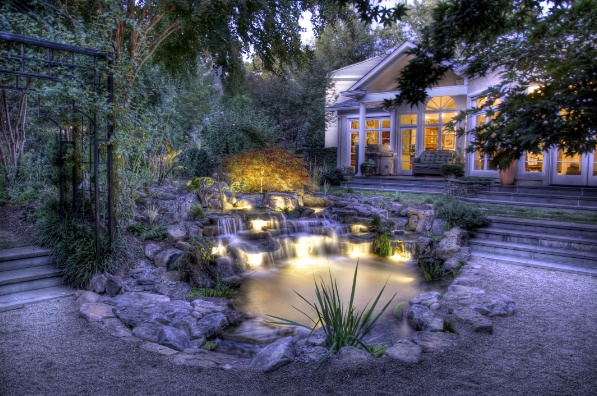
As beautiful and appealing as your water garden appears in daylight, imagine what it would look like at night when lighted! Fountains and cascades take on a whole new aspect if lit at night, becoming vibrant displays of moving, glittering water while the glow of submerged lights can create eerily attractive pools of incandescent color within the main pool.
By lighting up patios, poolsides, paths, decks, steps, bridges and barbecues, you can safely make full use of such areas at night. The safety aspect of lighting must be emphasized, as poor lighting can turn a charming daytime landscape into a potentially hazardous one at night. Lighting also improves security as well-lit gardens tend to deter possible intruders.
There are two methods of highlighting water in the garden, either from above the water surface or below. There are a number of units on the market for use as outdoor lighting, including some intended for underwater. Examine your garden and decide which features you want to highlight. Floodlights can be hidden in trees, among plants, or even fixed to buildings. If you direct these down onto the water surface, they will lift the pool out from the darkness.
Shine light at waterfalls to obtain glittering, moving reflections of the cascade. Try using a hidden spotlight to pick out the detail on a fountain ornament or sculpture and reflect it on the water surface. Shine uplighters into trees around the pool to create a green glow which will illuminate the surrounding area. The moving leaves will create a constantly changing pattern, and this will be stunningly reflected in the water.
Below the water, in-pool lighting can be used in a variety of ways. You could direct floodlighting across a body of water, causing a diffuse glow to emanate from the pool, or in ponds with clear water and pale colored bases, light can be directed at and reflected from the base.
We have many different lighting options for you to choose from and can also help you decide which garden features you want to emphasize and how to do it. Come in or give us a call.
Fall & Winter Pond Maintenance
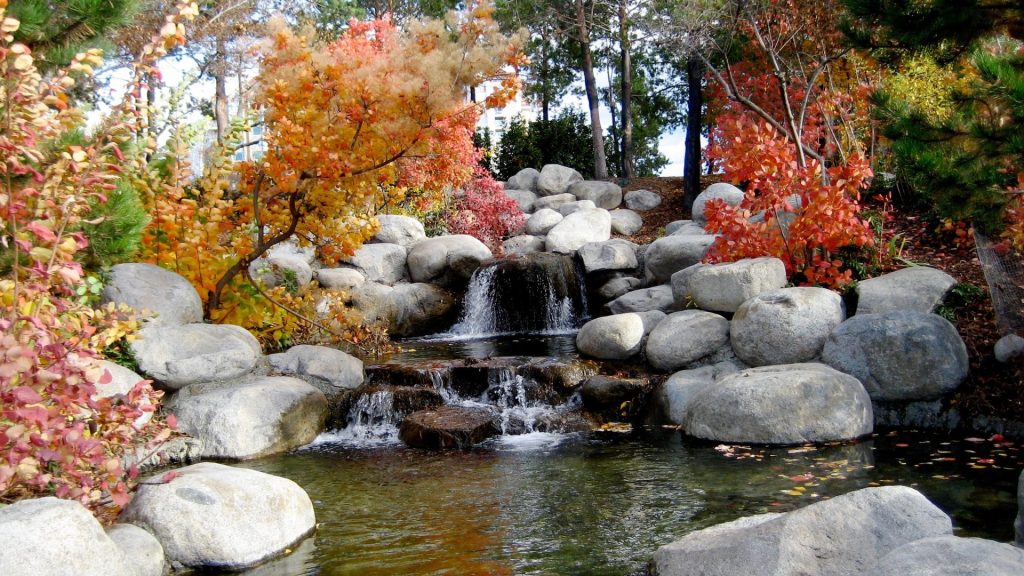
Fall and winter are crucial times for the pondkeeper. As tropical plants begin to die and leaves from surrounding trees begin to fall, the pond accumulates nitrogenous waste material that adversely affects water quality and creates ideal conditions for preventable disease and parasite problems come springtime.
The following routine maintenance should be performed before the water temperature stabilizes at 50°-55°F:
• Cover the pond with a net while leaves are falling.
• Drain 2/3 of the pond water, removing all the sludge and debris from the bottom of the pond and scrubbing algae off the liner.
• Cut back approximately 80% of the growth of live plants, particularly those with leaves under the surface.
• Remove any tender plants that won’t survive freezing weather.
• Cut back flowers, eaves and shoots of water lilies. Transplant and separate as required (this is an ideal opportunity to begin using Soiless Potting Media). Submerse the lilies in the deepest part of the pond.
• As most of the natural cover for the fish has been removed, provide them with shelter from predators. Sections of inert drain pipe and/or PVC pipe work well.
• Refill the pond, being sure to use a dechlorinator.
• Thoroughly clean the filter and any pump pre-filters.
• If they are to be left running, raise pumps off the bottom of the pond so that the warmer, denser water that accumulates there is left undisturbed.
• Restore a 3% salt solution to the pond water by adding 1 lb. of pond salt for every 100 gallons of water every 24 hours for three treatments (a total of 3 lbs. per 100 gallons). This will prevent fall and winter deaths caused by Costia, a parasite capable of surviving very cold temperatures and the number one killer of fish during the fall and winter seasons.
• Fatten the fish, providing them with an adequate supply of stored nutrients to survive the winter months. Feed as many times a day as your schedule will permit, ensuring that all the food being offered is eaten with 5-10 minutes. Use a high-protein food.
• Discontinue feeding entirely when the water temperature is consistently below 50°F. Regardless how tempting it may be to feed on the occasional balmy day, DO NOT feed your fish! At a water temperature of 50°F or less, digestive activity has ceased and this food will rot in the fishes’ intestines causing illness and probable death.
A pond which is properly prepared for winter will avoid many of the problems associated with the arrival of spring!
How to Manage Algae
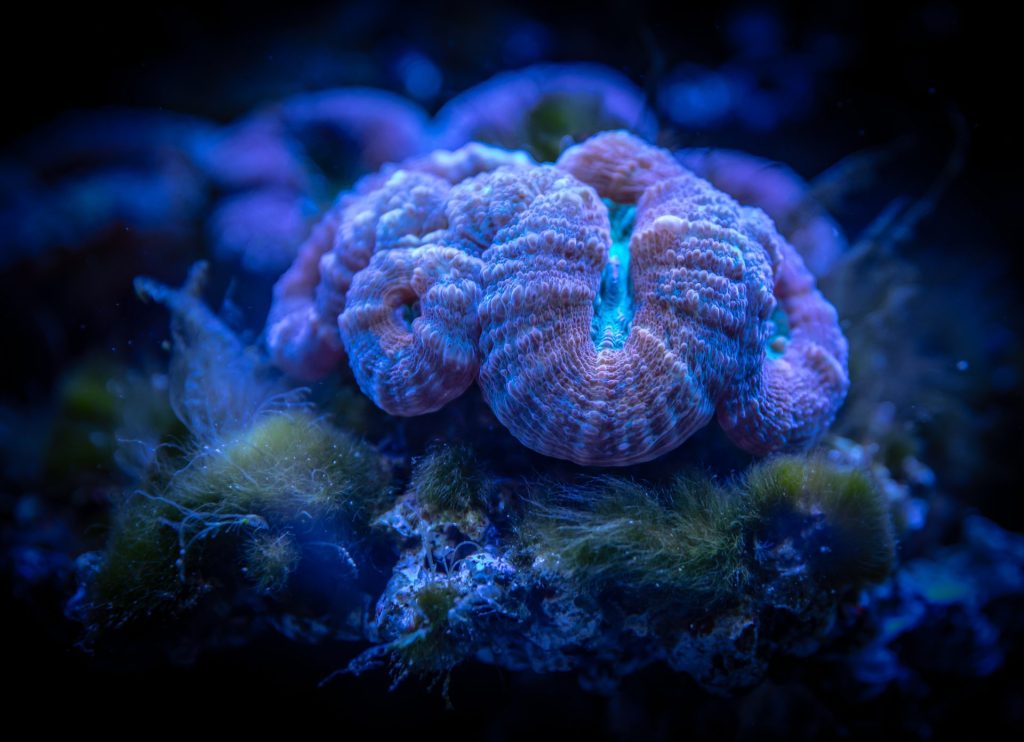 Algae are normal, and often necessary components of any aquatic ecosystem – they are far from being harmful. Algae growth only becomes a problem when it interferes with the aquariums aesthetic appearance or it begins to overtake delicate organisms.
Algae are normal, and often necessary components of any aquatic ecosystem – they are far from being harmful. Algae growth only becomes a problem when it interferes with the aquariums aesthetic appearance or it begins to overtake delicate organisms.
The most effective way to control problem algae is to control its food sources: nitrate, phosphate, carbon dioxide and dissolved organic matter. These nutrients are in short supply in natural environments such as tropical lakes, rivers and coral reefs. However, due to the aquarium’s closed system and density of organisms, nutrients can accumulate rapidly, forming a constant food source. Therefore understanding where these nutrients come from will help you control them.
Nitrate, phosphate and dissolved organics come from tap water, feeding the biological process. Some salt additive mixes also include these nutrients. Our goal is to manage the introduction of these food sources into the aquarium.
• Tap Water
Tap water in our area has measurable levels of nitrate, phosphate, silicate and heavy metals, all of which can promote algae growth and stunt the growth of desirable living plants, corals and invertebrates. Use of Reverse Osmosis (RO) water is the most efficient step in reducing the addition of these toxins. Just switching from tap water to RO water has resulted in cleaner aquariums with less maintenance for many aquarists. At Fintastic, we use RO water exclusively in all our saltwater systems and freshwater displays.
• Feeding
Ninety percent of the nitrogen in foods added to the aquarium ends up as nitrate in the water. Feeding also contributes to phosphate buildup. Overfeeding is typically the largest and most common source of algae nutrients. Feeding very small amounts twice a day (all food should be eaten within one minute) with no excess food laying on the bottom of the tank is your goal.
• The Biological Process
Mother Nature’s bacteria will reduce ammonia, nitrite and dissolved organics to nitrate. This process cannot be eliminated or altered as biological filtration is the most important type of filtration keeping your aquarium alive! Your goal is to keep organics levels as low as possible through proper feeding and husbandry of the aquarium. In saltwater, one of the newer methods is to eliminate the biological area in your trickle filter and follow the Berlin method. This process includes using plenty of live rock (2 pounds/gallon), live sand (3-4 inches deep), massive water flow, and strong protein skimming for filtration. Maintaining a calcium level of 400-450 ppm will promote the calcareous algae rather than the undesirable microalgae.
• Additions to the Aquarium
Additives for freshwater plant tanks (i.e. plant foods/fertilizers) should be done with test kits in hand to ensure the proper levels are maintained. Too little or too much will cause problems. Saltwater hobbyists should ensure their salt mix is nitrate/phosphate free and low in silicate. All other nutrient additives should be used very sparingly while other elements (calcium, strontium, molybdenum, iodine) should be consistently added.
• Lighting
Lighting problems can cause outbreaks of diatoms, red slime algae and blue-green slime algae. As lamps age, the light spectrum deteriorates, triggering the growth of undesirable algae. Fluorescent lamps (standard output) should be changed at least once a year, VHO lamps every four to six months, and metal halide and super compact lamps every year.
• Other Ways to Control Undesirable Algae
Once the introduction of nutrients is controlled, water changes incorporating vacuuming the detritus out of the gravel is the fastest way to remove the built-up impurities. Maintaining low levels can further be achieved by using nitrate and phosphate removing filter media. The addition of algae eating fish and snails is another natural way to keep the algae in check. Protein skimming is now considered a mandatory saltwater filtration component to reduce desolved organics. Ultraviolet (UV) sterilization will also kill free-floating algae spores. UV sterilization works effectively with freshwater and saltwater aquariums and ponds.
Problems with Aquatic Plants.
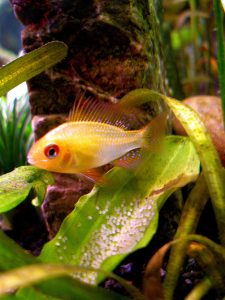
If you grow your aquarium plants at optimal light levels and the proper temperature, provide the proper pH and water hardness as well as supply them with all the needed nutrients you will probably never see plant diseases or deficiencies. Incorrect care is often the main cause of stunted growth and plant damage. Here I will discuss the different problems we encounter with plants, their causes and remedies.
Nutritional and trace element imbalances.
Errors made with supplying plants with the nutrients and trace elements can lead to plant damage and damage to the aquariums ecosystem. You should try to avoid these mistakes if at all possible.
Carbon Dioxide Deficiency. (CO2)
- Symptoms: The plants stay much smaller and grow more slowly than plants fertilized with CO2. Rough Calcium deposits on the leaves. Breakdown of the pH system causing a rise in pH.
- Causes: A lack of CO2 can arise even with optimal care. All plants use CO2 in their respiration process and it is difficult to maintain an equilibrium. Vigorously Aerated or agitated water increases CO2 loss, as the gas escapes into the air.
- Remedy: Regularly fertilize with CO2 and try to limit the amount of aeration and water agitation in your tank
Excess Carbon Dioxide CO2.
- Symptoms: The fish gasp at the water surface for air, as if they are suffocating.
- Cause: Oxygen deficiency resulting from over fertilization with co2, dirty filter material, poor lighting, too large of a fish load and bad tank maintenance.
- Remedy: Check all your maintenance procedures and filters, look for dead animals and plants. If you use an automatic CO2 fertilization system, adjust the amount released and make sure it does not run at night when the lights are off.
Oxygen Deficiency.
- Symptoms: The fish go through many bouts of disease and have a loss of vigor. With a long term deficiency the plants become stunted and the tank has excess algae growth.
- Causes: Insufficient nutrients or light, as a result the plants are not able to produce Oxygen from the assimilation of Carbon Dioxide. The Nitrogen cycle of the tank slows due to the aerobic bacteria not working or slowly working. The results are water overloaded with waste products and an excess of CO2.
- Remedy: Check the filters, lighting, fish population, all other tank maintenance procedures and especially your feeding habits. Make any needed alterations or corrections.
Potassium Deficiency.
- Symptoms: Yellowing of the marginal sections of the young leaves. Trace element deficiency, usually Iron Chlorosis.
- Cause: Your local water supplier or your Reverse Osmosis/DI filter removes the Potassium from the water. So a deficiency may arise.
- Remedy: Regular fertilization.
Excess Phosphate.
- Symptoms: Production of the Iron Phosphate causes the leaves to turn Black or Brown and to die. In addition if there is an excess of Nitrates your tank will experience an Algae bloom.
- Cause: Not performing your water changes on schedule or not changing enough water.Remedy: change a large portion of your water right away. Then modify your tank maintenance routine to include larger water changes or more frequent ones.
Cryptocoryne Disease
Cryptocoryne Rot.
- Symptoms: In the early stages small holes develop in the leaves or along the leaf margins. Advanced stages will affect the entire plant or group and cause the breakdown of all the leaves.
- Cause: Not known for sure, but excess Nitrate is a factor. Unclean water, improper nutrients and insufficient light also contribute to the onset of this disease. The odd thing about this disease that by trying to correct the above stated causes, often triggers this disease. Not regular maintenance, but for example doing a water change after a long period or changing the lights well after they were used up can bring about the onset.
- Remedy: Immediate improvement to the aquarium set up. Large water change, cleaning of the substrate, removal of all dead and decaying plant material. Don’t baby the plants, just leave them alone and they should recover in a few weeks.
- Prevention: Get on a regular maintenance schedule, do the water changes, keep up with the fertilization and change your lights when the recommended time arrives.
Iron Deficiency
Iron Chlorosis
- Symptoms: Yellow leaves that become brittle and glassy and finally fall off or rot away.
- Cause: Potassium deficiency, too little fertilizer and over-fertilization with Phosphate. In well fertilized aquariums it can be caused by an overly high amount of total Carbonate hardness in conjunction with a pH over 7.
- Remedy: Regular use of an Iron rich fertilizer compound or a substrate which contains Iron additives. If needed lower the Carbonate hardness of the water.
Manganese deficiency.
- Symptoms: Leaves turn Yellow but the Veins stay Green.
- Cause: Unbalanced Iron fertilization.
- Remedy: Use a fertilizer that contains all compounds needed by plants not just an Iron rich fertilizer.
Incorrect care and its end result.
Plants can often suffer from deficiency problems caused by the wrong choice in the aquarium substrate lighting and other accessories.
Problems in the substrate.
- Symptoms: Gas bubbles rising to the surface any time the substrate is disturbed, stunted plant growth, poorly rooted plants and rotting roots that are Black in color.
- Causes: The bottom material is too fine and/or has compacted. The Nutrients in the substrate have been used up.
- Remedy: loosen the bottom material and add some heavier grade material as well as a substrate fertilizer like Laterite. If this does not improve the conditions a replacement of the entire bottom material may be needed.
Wrong water temperature.
- Symptoms: If the water temperature is too cold the plants will cease to grow and eventually die. Too high of a water temperature the stem plants will have small leaves and long spaces between them and the Rosette plants will show little growth.
- Cause: Malfunctioning or broken aquarium heater. Using a heater with too little wattage to properly heat the water.
- Remedy: Purchase a new aquarium heater designed to handle your size tank. Keep a close eye on your temperature and watch for swings that could tell of a heater problem. For detailed information on heaters please go to the Basics section of the site.
Insufficient light.
- Symptoms: The plants are weak and spindly, the leaves are pale Green to Yellow and the stems are frail and thin. On the Rosette plants the stalks are weak and the leaves are small. Stem plants have only a few leaves and long spaces between them. Growth closest to the light is strong and compact, lower sections could be bare of leaves. A fine layer of Diatoms begins to grow.
- Causes: Not using enough wattage for your tank or not enough bulbs. The Fluorescent bulbs have lost there lumen output. The photoperiod is not long enough. Wrong spectrum lights heavy on the Red side, will cause tall and leggy plants. Blue spectrum bulbs will cause low squat growth and those in the Yellow/Green range will cause stunted growth.
- Remedy: Add more lighting, replace your tubes or increase the time your lights stay on. Purchase the right full spectrum bulbs, the so called plant bulbs are a poor choice.
Keeping a Saltwater Fish Tank
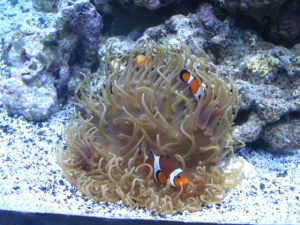 The Place to Acquire Saltwater Fish
The Place to Acquire Saltwater FishA saltwater fish store is unique in the fact that it is the perfect place to acquire a new addition to an individual’s collection of aquarium dwellers. Saltwater fish are notorious for being difficult to raise and provide a natural environment suitable for long term survival. This statement could be nothing as far from the truth. That used to be a true statement twenty years ago. Science and technology have perfected the art of saltwater fish keeping. At a saltwater aquarium store this difficult concept soon is dispelled. Saltwater Aquarium keepers are a breed that has the skills and knowledge of what it takes to keep these beautiful, colorful animals alive and thriving. There are such a multiple of choices for the avid saltwater enthusiast to indulge their interests and collection of species.
Types of Aquariums and the species kept
Maybe a saltwater collection is presented in a office location as a center piece of conversation. The aquarium could be made to look like a living reef, with the addition of live coral, sea sponges, fish, and a little live rock the allusion of the bottom of the oceans reefs can be a reality in the office. Watching these types of aquarium set-ups is very relaxing and very educational as well. Professionals at the saltwater fish store will be able to educate and inform the aquarium keeper how to keep their fish, corals, live rock, and any other type of invertebrate alive and thriving. Usually these individuals at the saltwater fish store are extremely educated from years of learning the craft of fish keeping. Water, temperature, food, species of fish all plays important roles in keeping an aquarium in a state of homoeostasis.
Difficulty of Species
Very exotic species can be purchased from the saltwater aquarium store. Most species are captured in the wild and begin their life in the wild. Usually the aquarium store has importers that specialize in different locations and different breeds. A type of fish that is viewed in a catalogue or another aquarium can usually be acquired if the name of the species is known. A reputable saltwater aquarium store will have the species stay in a isolation tank called quarantine. Quarantine is very important so that if the new fish, coral, animal has any parasites, diseases or other dangerous infectious problems it will not spread the problem. Another reason for quarantine is to get the animal accustomed to captivity and eating. Often new fish captured will not eat and often the water PH and other factors like salt content must be gradually introduced to be tolerated by the animal.
The Basics of Aquatic Plants
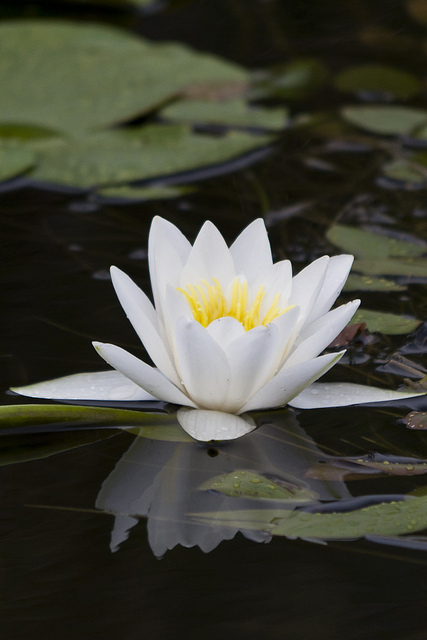 Aquatic plants are a very important step in achieving a truly balanced ecosystem pond. Regardless of why you got into the water gardening hobby, adding aquatic plants to the pond is an important part of the water garden. They provide beauty and naturalization with a huge array of plant choices.
Aquatic plants are a very important step in achieving a truly balanced ecosystem pond. Regardless of why you got into the water gardening hobby, adding aquatic plants to the pond is an important part of the water garden. They provide beauty and naturalization with a huge array of plant choices.
Most importantly, they help balance the pond’s ecosystem and provide valuable biological filtration that removes nitrogen, ammonia, nitrates and other minerals from pond water. These excess nutrients are often the cause of unsightly water conditions. The end result helps to minimize pond maintenance, leaving more time to enjoy your pond. Without aquatic plants, your pond would not be able to function as a complete ecosystem.
Aquatic plants can be classified into a few main categories: water lilies, marginal plants, floaters and submerged (also known as oxygenators). Plants can also be put into two basic types known as “tropical” and “hardy.” Hardy plants will over-winter in colder climates and tropical plants are more suited to warmer climates, although tropical plants are often used as annuals in colder climate zones.
Water Lilies
Water lilies are among the most popular of aquatic plants and are often the centerpiece of the water garden. A water garden never seems complete without a few beautiful water lilies. Not only are water lilies breathtaking but they provide valuable shade, which helps to keep the pond cool while providing refuge for pond fish. Ideally, thirty to sixty percent of the water surface should be covered with aquatic plants. There are also day and night blooming water lilies in many colors.
Marginals
The marginal plant group is the largest aquatic plant group by far, containing both hardy and tropical plants. Most of them are true perennials and come back year after year, like your favorite Daylily or Black-Eyed Susan. Marginal plants serve many functions such as adding beauty and providing valuable filtration. They are called “marginals” because they typically grow around the edges or “margins” of a pond or lake. Marginal plants thrive in wet soil or standing water that covers the crown or base of the plant by as little as two inches and up to as much as six inches. Some examples of marginals include sweet flag, marsh marigold, taro, canna, water iris and creeping jenny.
Floaters
Floating plants do just as their name indicates: they float on the water’s surface. Their roots dangle beneath the plant absorbing all their nutrients from the water. Most floating plants do a great job of filtering ponds by removing nutrients directly from the water as opposed to the soil where most other aquatic plants are situated or planted. The two most popular are water hyacinth and water lettuce.
Submerged
Like the name implies, this group of plants lives below the water surface. They are commonly referred to as oxygenators. Submerged aquatics do produce oxygen during most of the day. Submerged aquatic plants live entirely under water, almost. Some oxygenators bloom and the flowers often rise to the surface. They include plants such as parrots feather, hornwort, foxtail, cabomba and vallisneria. For the most part, submerged plants absorb their nutrients directly from the water. This means they compete with algae for nutrients, thereby helping to balance the ecosystem.
Putting it All Together
Just like their soil counterparts, a good mix of aquatic plants lends the best visual impact for your water garden. Marginals help to blend the pond into the surrounding landscape, while water lilies provide pops of color at the water’s surface. Take some time to familiarize yourself with all the wonderful options out there and you’ll soon find what most appeals to you.
Common Custom Made Fish Tanks
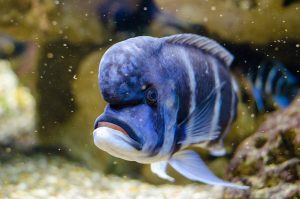 The lure and draw of having fish in one’s home is something that many people enjoy. It is part hobby, part passion and part decoration. This is because larger fish tanks and aquariums truly become a focal point inside of a home almost as soon as they are unveiled. Though many standard tanks are readily available, one may want to look in to custom aquariums so that they truly can have the right tank for their fish, their home and their personal sense of style. This is because such tanks can be designed in various shapes, sizes and even colors. The options are vast when it comes to creating and having crafted a truly unique and stylish aquarium.
The lure and draw of having fish in one’s home is something that many people enjoy. It is part hobby, part passion and part decoration. This is because larger fish tanks and aquariums truly become a focal point inside of a home almost as soon as they are unveiled. Though many standard tanks are readily available, one may want to look in to custom aquariums so that they truly can have the right tank for their fish, their home and their personal sense of style. This is because such tanks can be designed in various shapes, sizes and even colors. The options are vast when it comes to creating and having crafted a truly unique and stylish aquarium.
Custom aquariums allow the fish lover to pick and choose exactly what they want; based on need and not have to be bound by commercially available options that are more simplistic in design and appeal. This then allows the person to have made an aquarium that really does become an integral part of their home and their overall decor. The fact that various heights, shapes and enclosures can be chosen further allow for even greater customization of the aquariums. Imagination plays a key role in the process, and the fish owner and the designer can work together to find the best solution.
Not everyone has the exact same space available to house a tank, and this is where using custom aquariums really can be most beneficial. This allows the designer or design team to work around and with the space available. This is why some such tanks turn out to be tall, yet thin, tanks that rest atop ornate pillars. Additionally, one can choose to have aquariums that are built in to walls, turned in to tables or even connect from one room to another. The ideas and design options are truly amazing; with many turning out to be works of art. The addition of the fish once the tank is built and installed just adds to the overall look of the final display and this is why many people choose this route when they really want something unique, eye catching and ideal for fish and other aquatic life.
Fish for the Beginning Marine Aquarist
The beauty and successful maintenance of a saltwater aquarium requires attention not only to the chemical and temperature balance of the water, but also to the temperamental aspect of the fish themselves. It is essential that you balance their personalities (thereby increasing compatibility) by grouping passive fish with other passive fish and aggressive fish with other aggressive fish. This is the only way to avoid difficulties with aggression among the tank’s inhabitants, outbreaks of disease due to stress-induced lowered immune systems, and the inability to provide proper nutrition (aggressive eaters vs. passive eaters!).
You also want to avoid species that have unusual or unique food requirements. The health and longevity of marine fish depend on both a proper aquatic environment and a balanced diet that supplies complete nutrition, including trace elements they would receive in nature. Fish, unlike some invertebrates, obtain their trace elements from the food, not the water.
Typical choices for a non-aggressive community would include most cardinalfish, hardy butterflyfish, gobies, blennies, tilefish, green chromis damselfish, and certain wrasses. At the other end of the behavioral spectrum are the aggressive eels, certain scorpionfish, groupers, some of the larger damselfish and dottybacks, porcupinefish and triggerfish. If you are a beginning marine aquarist be sure to look for these compatibility factors before you stock your tank.
If you have any doubts or questions about your setup, please talk to our staff. They are always happy to advise and answer any questions you have. After all, we want to ensure the success of your saltwater venture and assist you to become an expert yourself!
